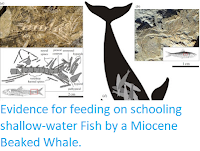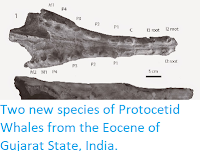Scientists from the Marine Mammal Center are examining the body of a juvenile Gray Whale, Eschrichtius robustus, that washed up on Sand Springs Beach on Angel Island in San Francisco Bay, California, on Thursday 8 March 2018. The 8.5 m animal, which was seen floating apparently dead in the water the previous day, shows no signs of any obvious disease or injury, but had an empty stomach, suggesting that it had died due to lack of food. An animal of this size would be expected to have left its mother's care within the last year, and begun foraging for itself. Grey Whales are Baleen Whales which feed by scraping benthic invertebrates from the sea bottom, a rather specialised diet for a Whale, and it is possible that this individual simply never learnt to feed on its own.
A stranded Gray Whale on Angel Island, California, this week. Marine Mammal Center.
Grey Whales were heavily hunted by commercial Whalers in the Pacific during nineteenth and twentieth centuries, (an Atlantic population was driven to extinction by Whaling in the eighteenth century). The species has been protected under US law since 1936, and by the International Whaling Commission since 1949, leading to a recovery in the population, with the Californian population currently thought to comprise about 26 000 (the indigenous Makah people of Washington State are in theory allowed to take a small number of Whales using traditional methods, but in practise seldom do so, due to the controversy this tends to cause, with the last two recorded hunts occurring in 1999 and 2007). This means that the deaths of Whales due to natural causes, while distressing to many Human observers, can be seen as a symptom of a recovering population. Such events also provide an opportunity for scientists to study the animals that would not otherwise arise.
See also...
Follow Sciency Thoughts on
Facebook.







